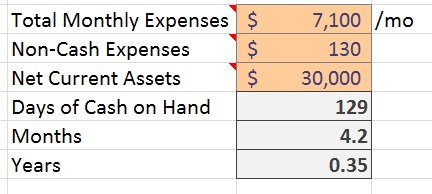Cash is the lifeblood of a small business. Most likely, your small business doesn’t have some magical line of credit or a local bank that is ready to bankroll your operations. If you just landed some Venture Funding, congratulations! Now you need to understand how long that’s actually going to last.
We’ll look at two KPIs or metrics which show you where you’re at: Drop Dead Date and Days of Cash on Hand. I combined these because they’re basically identical for any company that is not making sales and profits. If you’re making a net profit, then you switch from watching a Drop Dead Date to watching your Days of Cash on Hand.
Drop Dead Date
The Drop Dead Date is the day you hit zero cash. Your goal as a business owner is to beat your Drop Dead Date. You can only do this by getting to positive Net Income before the actual Drop Dead Date with sales. It should be based on some reasonable Forecasting of expenses and income.
If you’re operating at a negative net income or are “Pre-Revenue” you should watch these numbers like a hawk. There is nothing more real to a team than the realization that overspending on that one thing just brought your Drop-Dead-Date forward by a Month.
Days of Cash on Hand
Days of Cash on Hand is how many days you could cover your expenses if all of your income stopped for some reason. This would be a catastrophic event, but in reality, it is a way to measure how healthy your cash reserves are. Banks and investors will want to see 3-6 Months of cash on hand.
You can see the impact of sales increase in your organization by looking at the difference between the Days of Cash on Hand and the Days to Drop Dead Date. Your sales extend the lifetime of your company, so go make a Sale!
Drop Dead Date KPI Template
OK, so one key topic I’m assuming you can do here is Forecasting. I’m working on that blog as we speak. You need to understand what your forecasted expenses are going to be, realistically. And then you should review your forecasts on a monthly basis to make sure they still make sense.

You also need to open, update and review this KPI and calculation every month once your books are closed. If your forecast shows that you aren’t passed a drop-dead date yet, then start strategizing on how you’re going to beat that date.
Drop Dead DateForecasted Income and Expense
Your Forecast should include a monthly level of expected expenditures and expected sales. If you haven’t spent much time on these, I’d suggest you do so now. You need to have an idea how you expect things to go in the future. Be real here. Don’t be overly optimistic. Also, make sure you have some real values here based on seasonality and conservative sales growth numbers, not just a month to month copy of the same values.
Non-Cash Expense Exclusions
Non-cash expense is items like depreciation which are on your P&L and Balance Sheet for GAAP and tax purposes. In this case, since we’re working on your cash, not adjusted taxable income, we want to exclude those. They should be listed out separately in your finances. Put them here.
Net Current Assets (Accessible Cash)
Fill in the Net Current Assets from your latest P&L. This should be representative of your available cash or cash you can acquire within 30 days. Ideally, cash should be the majority of what’s in Net Current Assets. In the official definition of current assets you just have to be able to convert to cash within the year: so be wary of that and use an adjusted value if you can’t get the cash before your Drop Dead Date. I’d recommend you only use assets you can convert to cash within 30 days.
Days of Cash on Hand KPI
This is the annual balance sheet method interpreted for Monthly review, as any useful KPI would be. It’s fairly straightforward, just use the historical values from your latest financials to get an idea where you’re at. As mentioned before, you should keep 3-6 Months of cash on hand.

Forecasted Days of Cash on Hand
I’m adding this into the first sheet because you already filled in all of the Forecast information to determine your drop-dead date. The key difference is that this is a Managerial view of your days of cash on hand, which should be based on your actual business forecast, not based on history. When you get past having a Drop Dead Date, you should keep reviewing this metric to ensure you have reasonable cash reserves.


